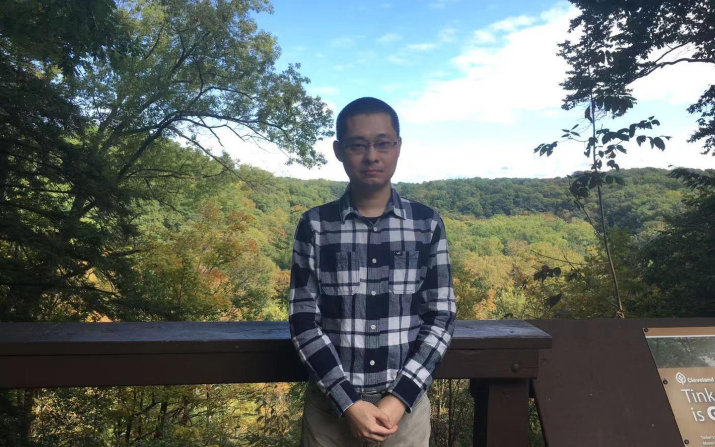
Bowen Dong defends doctoral dissertation

On July 17, PhD candidate Bowen Dong successfully defended his thesis, “Development of Nanostructured Soft Magnetic Composite Materials using the Field Assisted Sintering Technique."
Years of researching nanocrystalline soft magnetic alloys, nonequilibrium processing (melt-spinning) and Field Assisted Sintering prepared Dong for his thesis. He also presented work from two SBIR research projects done in collaboration with Powdermet Inc.
During his time at CWRU, Dong was involved in helping his advisor, Associate Professor Matthew Willard, establish the research lab for nanocrystalline soft magnetic materials study. Dong built a strain-gage based magnetostriction measurement device and repaired and recovered a large melt-spinning system that was donated by NASA. Both are instrumental in the research lab.
Dong, who grew up in Beijing, China, credited Willard as his biggest influence during his CWRU studies. “I’ve learned different expertise during the time under his supervision in the aspect of conducting research work and got encouragement when facing difficulties.”
While studying applied physics as an undergraduate at Harbin University of Science and Technology in China, Dong was first introduced to the field of materials science and engineering. “I was interested in using physics to approach real world problems, which means I should go on to do research in either condensed matter physics or materials science,” he said. “The former one is too theoretical for me, therefore, I chose materials science and engineering, which is more experimental.”
After earning his Bachelor of Science in applied physics, Dong earned his Master of Science in materials science and engineering from Cornell University.
Dong, whose main scientific interests include soft magnetic materials, novel materials processing techniques, nonequilibrium processing, and high-throughput characterization, plans to start his career as a postdoctoral research associate at Ames Laboratory in Ames, Iowa after graduation. His long term goals include pursuing a career in research and development in the industry.
Dong's Abstract:
In this study, the development of nanostructured soft magnetic composite materials using the field-assisted sintering technique (FAST) from core-shell powders has been investigated. FAST consolidation experiments have been performed on a series of core/shell powders. The crystal structure, microstructure, relative density, resistivity, and magnetic properties of the compacted samples were characterized.
Through the study on the FAST consolidation of core/shell Fe/SiO2 (30-50 nm, SiO2 thicknesses) powders, the upper limit of the sintering temperature when using graphite tooling for Fe-based core/shell powder was determined to be 1050 ºC. A processing condition of 25 MPa loading pressure, 800 ºC sintering temperature and 10 minutes holding time was successfully used for FAST consolidation of core/shell Fe/SiO2 (30-50 nm, SiO2 thicknesses) powders. An ‘edge effect’ of deteriorated magnetization (drop by up to 6.6 % within the 2 mm distance to the edge) and coercivity (increase by up to 140 % within the 2 mm distance to the edge) on the radial direction of the compacted Fe/SiO2 (30-50 nm, SiO2 thicknesses) samples sintered at 850 ºC, 950 ºC, and 1050 ºC for 1 hour was discovered. This effect was found to be connected to the decreasing relative density achieved (drop by up to 4.5 % within the 2 mm distance to the edge) in the compacts at the locations near the circumference. For the 1050 ºC sintered Fe/SiO2 compact, this phenomenon was the most pronounced. Within the 2 mm distance in the radial direction approach to the edge, the magnetization magnetization of the sample dropped by 6.6 % from the averaged value of 212 Am2/kg of the whole compact, and coercivity increased about 200 % from the averaged value of 591 A/m, while the relative density decreased from the averaged value of 99 % for the compact to 94 %. The decreasing relative density is attributed to two factors: (1) The temperature gradient that led to lower local sintering temperature at the position approaching the edge. (2) The lower stress distributed on the area near the edge during the consolidation process.
The study on the FAST consolidated of Fe/SiO2 (30-50 nm, 800 nm, and 1.2µm SiO2 thicknesses), nanocrystalline Fe/SiO2 (30-50 nm, SiO2 thicknesses), and nanocrystalline FeCo/SiO2 (30-50 nm, SiO2 thicknesses), showed a microstructure with SiO2 shell debris distributing in bulk formed by Fe and FeCo. This microstructure cannot provide separation of the conductive magnetic alloy particles from each other, still less than the insulation to diminish the eddy current. The formation of this microstructure is explained bythe mismatch of the thermal expansion coefficients of the Fe and FeCo in the core and the SiO2 in the shell of the composite powders. The possible solutions to the issue are to use pliable shell material and by further increasing the content of the shell material. The possible solutions tested by the consolidation of the FeCo/BN nanosheet (1 wt.%, 3.wt.%, and 5 wt.% BN nanosheet contents), and the FeCo/MnZn ferrite (5.01 wt.%, 7.33 wt.%, 11.56 wt.%, and 17.10 wt.% MnZn ferrite contents). Microstructure with FeCo phases separated by the matrix formed by the shell materials has been achieved.
The FeCo/MnZn ferrite core/shell powders were also used to develop the full exchange-coupled bulk composite compact. A reaction between FeCo and the MnZn ferrite, which results in a rock salt phase with poor magnetic properties, was observed. The thermodynamics the reaction has been investigated and revealed a driving force of 35 ~ 45 kJ/mol for MnxZn1-xFe2O4 (0 < x < 1) at the 800 ºC temperature in the FAST process.
Finally, a small grain growth has been observed in the FAST consolidated of nanocrystalline Fe/SiO2 (30-50 nm, SiO2 thicknesses) (from 21.9 nm to 27.3 nm), and nanocrystalline FeCo/SiO2 (30-50 nm, SiO2 thicknesses) (from 15.9 nm to 19.6 nm ). It indicates that the Field Assisted Sintering Technique (FAST) is a feasible method to develop nanocrystalline Fe and nanocrystalline FeCo based composites.
